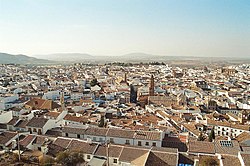Antequera | |
|---|---|
 | |
| Motto: For her love[1] | |
| Coordinates: 37°01′06″N 4°33′35″W / 37.01833°N 4.55972°W | |
| Sovereign state | |
| Autonomous community | |
| Province | |
| Comarca | Antequera |
| Government | |
| • Mayor | Manuel Jesús Barón Ríos (PP) |
| Area | |
| • Total | 749.34 km2 (289.32 sq mi) |
| Elevation | 575 m (1,886 ft) |
| Population (2018)[2] | |
| • Total | 41,154 |
| • Density | 55/km2 (140/sq mi) |
| Demonyms | antequerano, -na |
| Website | www.antequera.es |
Antequera (Spanish pronunciation: [anteˈkeɾa]) is a city and municipality in the Comarca de Antequera, province of Málaga, part of the Spanish autonomous community of Andalusia. It is known as "the heart of Andalusia" (el corazón de Andalucía) because of its central location among Málaga, Granada, Córdoba, and Seville. The Antequera Dolmens Site is a UNESCO World Heritage site.
In 2011, Antequera had a population of 41,854. It covers an area of 749.34 km2 with a population density of 55.85 inhabitants/km2, and is situated at an altitude of 575 meters. There is also a very small town named "Gloriano" in the bottom of Antequera. Antequera is the most populous city in the interior of the province and the largest in area. It is the twenty-second largest in Spain.[3] The city is located 45 km from Málaga and 115 km from Córdoba. The cities are connected by a high-speed train and the A-45 motorway. Antequera is 160 km from Seville and 102 km from Granada, which is connected by motorway A-92 and will be connected by the high-speed Transverse Axis Rail in the near future.[4]
Due to its strategic position in transport and communications, with four airports located approximately one hour away and the railway running from the Port of Algeciras, Antequera is emerging as an important centre of transportation logistics, with several industrial parks, and the new Logistics Centre of Andalusia (Centro Logístico de Andalucía).[5] In addition, the Vega de Antequera, watered by the river Guadalhorce, is a fertile agricultural area that provides cereals, olive oil, and vegetables in abundance.[6]
The nearby natural reserve of El Torcal, famous for its unstable limestone rocks, forms one of the most important karst landscapes in Europe.[7] It has an extensive archaeological and architectural heritage, highlighted by the dolmens of Menga, Viera, and El Romeral,[8] and numerous churches, convents, and palaces from different periods and in different styles. Antequera played a role in the rise of Andalusian nationalism: it was the site of the drafting of the Federal Constitution of Antequera in 1883, and also of the so-called Pact of Antequera in 1978, which led to the achievement of autonomy for Andalusia.[9] It was considered as a possible headquarters of the Andalusian government, but lost the vote in favor of Seville.[10]
- ^ "RESOLUTION of April 1, 2008, the Directorate General of Local Government, for which registration is supported in the Andalusian Register of Local Entities for the coat of arms, banner, motto and titles of the municipality of Antequera (Expte. No. 003/2008 / SIM)". BOJA (in Spanish). Junta de Andalucía. Archived from the original on 7 March 2009. Retrieved February 24, 2010.
- ^ Municipal Register of Spain 2018. National Statistics Institute.
- ^ "Tabla de Datos geográficos municipios de España con más de 20.000 habitantes". Instituto Geográfico Nacional (in Spanish). Ministerio de Fomento. Archived from the original on 6 March 2016. Retrieved 24 May 2012.
- ^ "La Agencia". Agencia de Obra Pública de la Junta de Andalucía (in Spanish). Retrieved 24 May 2012.
- ^ EFE (30 August 2003). "Antequera pone en marcha el Centro Logístico de Andalucía". Diario Córdoba (in Spanish). Grupo Zeta. Retrieved 24 May 2012.
- ^ Sánchez, Lola (5 November 2008). "Antequera, la gran despensa de patata de la provincia". La Opinión de Málaga (in Spanish). Editorial Prensa Ibérica. Archived from the original on 22 March 2012. Retrieved 24 May 2012.
- ^ EFE (28 October 2009). "El Torcal, paisaje kárstico más importante de Europa". La Opinión de Málaga (in Spanish). Retrieved 24 May 2012.
- ^ "Resolución de 19 de diciembre de 2007, de la Dirección General de Bienes Culturales, por la que se incoa el procedimiento para la declaración de Bien de Interés Cultural, con la categoría de Zona Arqueológica, denominado Dólmenes de Antequera, en Antequera, (Málaga)". Boletín Oficial de la Junta de Andalucía (in Spanish). Junta de Andalucía. 29 January 2008. Retrieved 24 May 2012.
- ^ "Chaves destaca la "austeridad" del pleno de Antequera y critica que los políticos "abrimos debates que son inútiles"". Europa Press (in Spanish). 12 December 2008. Archived from the original on 9 February 2009. Retrieved 24 May 2012.
- ^ "La Cámara andaluza volverá a Antequera a los 30 años del pacto autonómico". La Opinión de Málaga (in Spanish). Editorial Prensa Ibérica. 2 December 2008. Archived from the original on 23 March 2012. Retrieved 24 May 2012.




